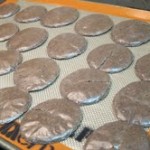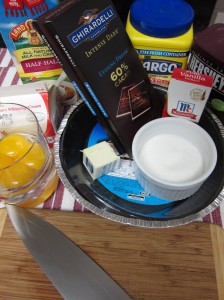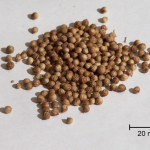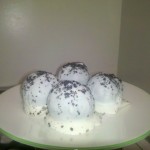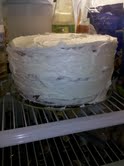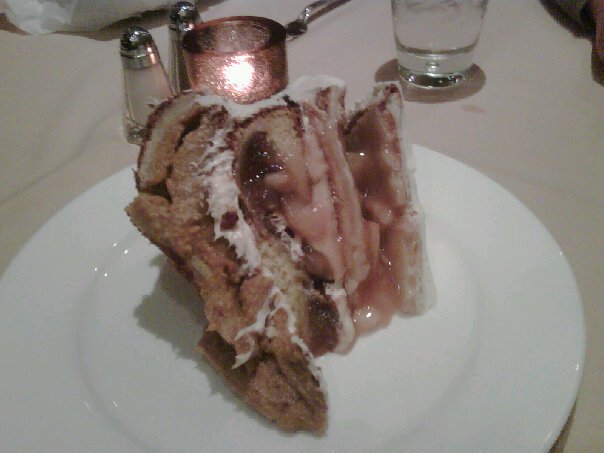When I first started writing for dcfüd, I mentioned that I’d be writing about my successes and my failures. And much like the title screen for (500) Days of Summer did, I have to warn you up front: this is not a success story.
A while back, I tried making macarons, those small, French sandwich cookies made with almond flour, egg whites, and a lot of luck. They didn’t work out for me – the batter ran out of my piping bag like water, the cookies ended up much bigger than I’ve ever seen commercially, and though they tasted okay, they just didn’t look very good. I’ve been told that I’m a bit of a perfectionist professionally, and sometimes that bleeds over into my cooking. But it’s for good reason – most professional chefs that I’ve read offer some variation on the cliché that we “eat with our eyes first” – so presentation really does matter.
Go on: take a look at the photos of the “macarons” entry at Wikipedia (http://en.wikipedia.org/wiki/Macarons). I’ll wait. Notice the beautiful pastel colors (though those are created by artificial food dyes), the symmetrical cookie halves, and the slight “foot” created during the bake? Those are the hallmarks of a professionally made and well-executed macaron. I wanted to try them out again this week. (And I’m still competing with my coworkers over desserts, so this would be a coup if I could pull it off!)
Step one: sources and methods. One of my go-to references for baking and desserts is the Baking Bites blog (http://bakingbites.com/), run by a Los Angeles-based author named Nicole Weston. She posted her recipe for chocolate macarons with vanilla buttercream filling recently (http://bakingbites.com/2012/01/chocolate-macarons-with-vanilla-buttercream-filling/), and once I saw it, I put almond flour on my grocery list. Fair warning: one pound of that ran more than $10 at my local supermarket. There’s not a whole lot of almond flour in one batch, so you can certainly try again, but don’t bother trying to chop your own almonds into flour in your food processor – you’ll end up with chunks rather than the fine powder you need.
Step two: prep. I set up two roasting pans, but I only have one SilPat, so I lined the other one with parchment paper. One equipment note here – every macaron recipe I’ve ever seen has specified measuring ingredients by weight rather than by volume. This is a great tip for baking generally, and I’m told that most professional chefs use scales in their pastry work. After weighing out the dry ingredients, I whisked them together in a mixing bowl and started separating my eggs. Once the sugar syrup went onto the heat, the recipe started moving quickly, and it might be then that it got away from me.
Step three: failure. Maybe macarons are my personal unicorn, but I just couldn’t get them right this time, either. The almond dough came together fairly easily, but the Italian meringue that the Baking Bites recipe suggests either wasn’t whipped enough or not folded gently enough into the batter. Not to blame the recipe, of course – those would be my fault! After piping and baking (and my pastry bag skills leave something to be desired…), I found some flat macarons with cracked shells when I opened the oven. Several of them stuck to the pans despite my best efforts with silicone and parchment paper, but I’m told that’s not unusual. And worst of all, my frosting went wrong, looking grainy and brown rather than nicely whipped. I tend to use a bit more vanilla in my desserts than recipes call for, and I think my vanilla extract might have done a bit more coloring than I wanted it to here. Mea culpa!
But all was not lost – I pulled a container of dark chocolate frosting out of the pantry and started sandwiching the cookies together with a dollop each. They’re not the most visually appealing macarons I’ve ever seen by a long shot, but my beautiful wife (God bless her!) assured me that they’re quite good. We’ll see what my co-workers say.
This dessert is a real challenge, so I’d love to hear about your experience with it or with other macaron recipes. Let me know in the comments if you’ve managed to conquer the French. Enjoy!
Chocolate Macarons with Vanilla Buttercream Filling
Recipe courtesy Baking Bites
180 g almond flour/almond meal
200 g confectioner’s sugar
30 g cocoa powder
4 large room-temperature egg whites, divided
180 g sugar (granulated)
¼ cup water
For vanilla buttercream:
1/3 cup room-temperature butter
1 ½ tsp vanilla extract
1 tbsp milk
2 cups confectioner’s sugar
Prep two roasting pans with non-stick surfaces, either SilPats or parchment paper.
Sift together almond meal, confectioner’s sugar, and cocoa powder in a mixing bowl. Using the paddle attachment, mix with two of the egg whites until a thick dough comes together. Be sure to scrape the bottom of the bowl to ensure all of the dry ingredients are mixed. Once the dough is together, set aside and wash out your mixing bowl.
In a saucepan, heat granulated sugar and water to a rolling boil, whisking to ensure sugar dissolves. Boil for at least 30 seconds.
Back in the stand mixer, beat the other two egg whites until soft peaks form. Then slowly add the syrup into the egg whites while continuing to beat on medium. Be careful here, as the syrup is hot and the mixer will send it everywhere unless you’re cautious. Once the syrup has been fully incorporated, beat until you have a thick, fluffy meringue, set aside and wash out the mixing bowl again (unless you’re lucky enough to own extras!)
Stir about 1/3 of the meringue into the chocolate dough, then fold in the remaining meringue in a couple more additions. Using a pastry bag or a zip-top plastic bag with a snipped corner, pipe the resulting batter out onto the pans in tablespoon-sized portions with about an inch between them.
Let the piped batter sit for 20 minutes or so while preheating the oven to 350 degrees. Bake for about 12 minutes, then cool on the sheet or a cooling rack before frosting and sandwiching.
Vanilla Buttercream Frosting
Beat the butter until soft, then add the vanilla extract, milk, and confectioner’s sugar. Beat until light and creamy, then spoon or pipe between your cookie shells. And if nothing else, keep a backup frosting in the pantry!
-HML
[ad]

